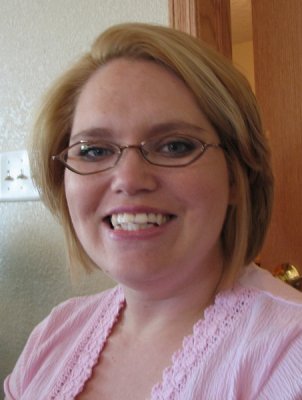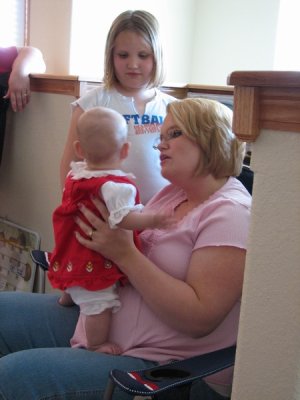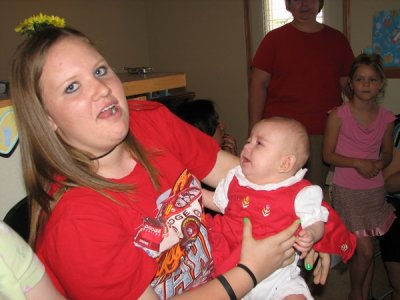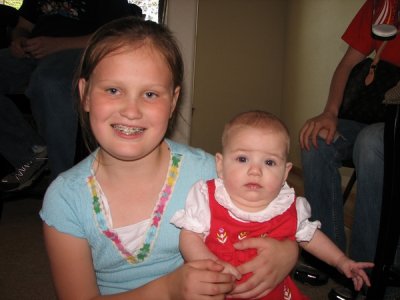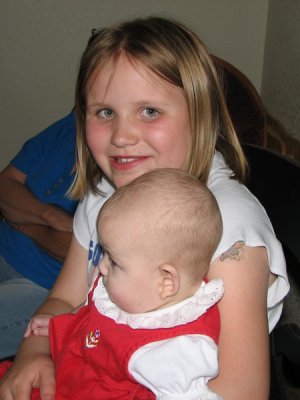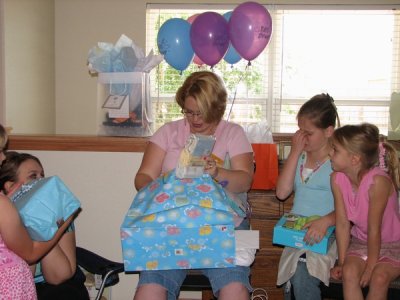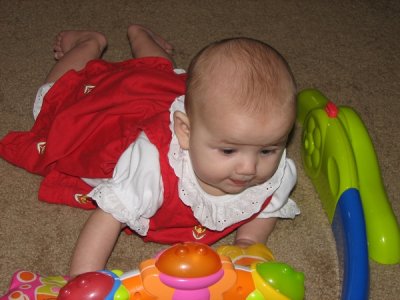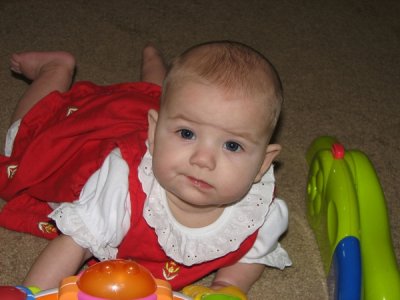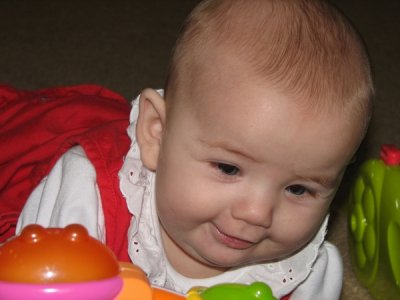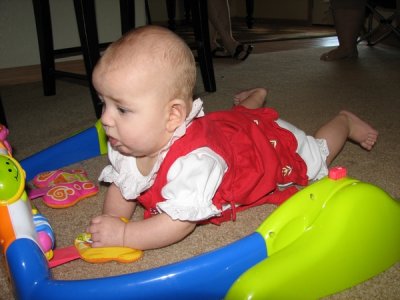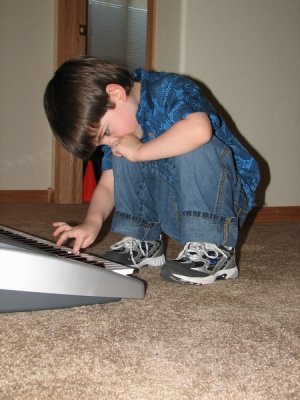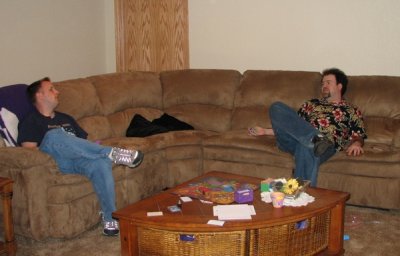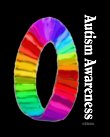The road to Hannah’s mind opened a few days before her 13th birthday.
Her parents, therapists, nutritionists and teachers had spent years preparing the way. They had moved mountains to improve her sense of balance, her sensory perception and her overall health. They sent in truckloads of occupational and physical therapy and emotional support. But it wasn’t until the fall of 2005 that traffic finally began to flow in the other direction. Hannah, whose speech was limited to snatches of songs, echoed dialogue and unintelligible utterances, is profoundly autistic, and doctors thought she was most likely retarded. But on that October day, after she was introduced to the use of a specialized computer keyboard, Hannah proved them wrong. “Is there anything you’d like to say, Hannah?” asked Marilyn Chadwick, director of training at the Facilitated Communication Institute at Syracuse University.
With Chadwick helping to stabilize her right wrist and her mother watching, a girl thought to be incapable of learning to read or write slowly typed, “I love Mom.”
A year and a half later, Hannah sits with her tutor at a small computer desk in her suburban home outside New York City. Facilitated communication is controversial (critics complain that it’s often the facilitator who is really communicating), but it has clearly turned Hannah’s life around. Since her breakthrough, she no longer spends much of her day watching Sesame Street and Blue’s Clues. Instead, she is working her way through high school biology, algebra and ancient history. “It became obvious fairly quickly that she already knew a lot besides how to read,” says her tutor, Tonette Jacob.
During the silent years, it seems, Hannah was soaking up vast storehouses of information. The girl without language had an extensive vocabulary, a sense of humor and some unusual gifts. One day, when Jacob presented her with a page of 30 or so math problems, Hannah took one look, then typed all 30 answers. Stunned, Jacob asked, “Do you have a photographic memory?” Hannah typed “Yes.”
Like many people with autism, Hannah is so acutely sensitive to sound that she’ll catch every word of a conversation occurring elsewhere in the house, which may account for much of her knowledge. She is also hypersensitive to visual input. Gazing directly at things is difficult, so she often relies on her almost preternatural peripheral vision. Hannah’s newfound ability to communicate has enabled her intellect to flower, but it also has a dark side: she has become painfully aware of her own autism. Of this, she writes, “Reality hurts.”
MORE THAN 60 YEARS AFTER AUTISM WAS first described by American psychiatrist Leo Kanner, there are still more questions than answers about this complex disorder. Its causes are still uncertain, as are the reasons for the rapidly rising incidence of autism in the U.S., Japan, England, Denmark and France. But slowly, steadily, many myths about autism are falling away, as scientists get a better picture of what’s going on in the bodies and brains of people with autism and as more of those who are profoundly affected, like Hannah, are able to give voice to their experience. Among the surprises:
• Autism is almost certainly, like cancer, many diseases with many distinct causes. It’s well known that there’s a wide range in the severity of symptoms–from profound disability to milder forms like Asperger syndrome, in which intellectual ability is generally high but social awareness is low. Indeed, doctors now prefer the term Autistic Spectrum Disorders (ASD). But scientists suspect there are also distinct subtypes, including an early-onset type and a regressive type that can strike as late as age 2.
• Once thought to be mainly a disease of the cerebellum–a region in the back of the brain that integrates sensory and motor activity, autism is increasingly seen as a pervasive problem with the way the brain is wired. The distribution of white matter, the nerve fibers that link diverse parts of the brain, is abnormal, but it’s not clear how much is the cause and how much the result of autism.
• The immune system may play a critical role in the development of at least some types of autism. This suggests some new avenues of prevention and treatment.
• Many classic symptoms of autism–spinning, head banging, endlessly repeating phrases–appear to be coping mechanisms rather than hard-wired behaviors. Other classic symptoms–a lack of emotion, an inability to love–can now be largely dismissed as artifacts of impaired communication. The same may be true of the supposedly high incidence of mental retardation.
• The world of autism therapy continues to be bombarded by cure-of-the-day fads. But therapists are beginning to sort out the best ways to intervene. And while autism is generally a lifelong struggle, there are some reported cases in which kids who were identified as autistic and treated at an early age no longer exhibit symptoms.
THE CURIOUS INCIDENCE
DR. THOMAS INSEL, DIRECTOR OF THE National Institute of Mental Health (NIMH), which funds much of the nation’s autism research, remembers a time when the disorder was rarely diagnosed. “When my brother trained at Children’s Hospital at Harvard in the 1970s, they admitted a child with autism, and the head of the hospital brought all of the residents through to see,” says Insel. “He said, ‘You’ve got to see this case; you’ll never see it again.’”
Alas, he was mistaken. According to the Centers for Disease Control and Prevention (CDC), about 1 in 166 American children born today will fall somewhere on the autistic spectrum. That’s double the rate of 10 years ago and 10 times the estimated incidence a generation ago. While some have doubted the new figures, two surveys released last week by the CDC were in keeping with this shocking incidence.
No one can say why the numbers have soared. Greater awareness and public health campaigns to encourage earlier diagnosis have surely played a part, since in the past, many such children were probably labeled retarded or insane and hidden in institutions. But environmental factors may also be contributing to the spike. To get to the bottom of that mystery and others, federal funding for autism research has more than tripled in the past decade, to $100 million, although it pales in comparison with the estimated $500 million spent on childhood cancers, which affect fewer youngsters.
At the Center for Children’s Environmental Health and Disease Prevention at the University of California at Davis, toxicologist Isaac Pessah is studying hair, blood, urine and tissue samples from 700 families with autism. He’s testing for 17 metals, traces of pesticides, opioids and other toxicants. In March Pessah caused a stir by releasing a study that showed that even the low level of mercury used in vaccines preserved with thimerosal, long a suspect in autism, can trigger irregularities in the immune-system cells–at least in the test tube. But he does not regard thimerosal (which has been removed from routine childhood vaccines) as anything like a smoking gun. “There’s probably no one trigger that’s causing autism from the environmental side,” says Pessah, “and there’s no one gene that’s causing it.”
Indeed, most researchers believe autism arises from a combination of genetic vulnerabilities and environmental triggers. An identical twin of a child with autism has a 60% to 90% chance of also being affected. And there’s little doubt that a vulnerability to ASD runs in some families: the sibling of a child with autism has about a 10% chance of having ASD. Gene scientists working on autism have found suspicious spots on chromosomes 2, 5, 7, 11 and 17, but there are probably dozens of genes at work. “We think there are a number of different autisms, each of which could have a different cause and different genes involved,” says David Amaral, research director of the MIND (Medical Investigation of Neurodevelopmental Disorders) Institute, also at U.C. Davis.
Amaral is heading MIND’s efforts to assemble a database of clinical, behavioral and genetic information on 1,800 autistic kids. One goal is to clearly define autism subtypes. “It’s hard to do the genetics if you’re talking about four or five different syndromes,” says NIMH chief Insel. “Does the presence of seizures define a separate illness? What about the kids who seem to develop normally for the first year and a half and then regress–is that a separate thing?” And what about the large number of autistic kids who have serious gastrointestinal problems and the many with immune dysfunctions–are they distinct subtypes?
Amaral and colleague Judy Van de Water believe they are onto a major discovery about the origins of at least one type of autism–a strongly familial variety. They have detected aberrant antibodies in the blood of kids from families with a pattern of ASD and, significantly, in mothers with more than one autistic child. “These antibodies are actually raised against proteins in the fetal brain,” says Amaral, who recently submitted a paper on the discovery. The working hypothesis is that these antibodies may alter brain development in ways that lead to autism. If correct, the finding could lead to a maternal blood test and the use of a therapy called plasmapheresis to clear antibodies from the mother’s blood. “You get a sense of the excitement,” says Amaral, “if you could prevent, say, 20% of kids from getting autism. But we don’t want to raise false hopes.”
THE AUTISTIC BRAIN
WHETHER THE CAUSE IS MATERNAL antibodies, heavy metals or something else, there is no question that the brains of young children with autism have unusual features. To begin with, they tend to be too big. In studies based on magnetic resonance imaging (MRI) and basic tape-measure readings, neuroscientist Eric Courchesne at Children’s Hospital of San Diego showed that while children with autism are born with ordinary-size brains, they experience a rapid expansion by age 2–particularly in the frontal lobes. By age 4, says Courchesne, autistic children tend to have brains the size of a normal 13-year-old. This aberrant growth is even more pronounced in girls, he says, although for reasons that remain mysterious, only 1 out of 5 children with autism is female. More recent studies by Amaral and others have found that the amygdala, an area associated with social behavior, is also oversize, a finding Amaral believes is related to the high levels of anxiety seen in as many as 80% of people with autism.
Harvard pediatric neurologist Dr. Martha Herbert reported last year that the excess white matter in autistic brains has a specific distribution: local areas tend to be overconnected, while links between more distant regions of the brain are weak. The brain’s right and left hemispheres are also poorly connected. It’s as if there are too many competing local services but no long distance.
This observation jibes neatly with imaging studies that look at live brain activity in autistic people. Studies using functional MRI show a lack of coordination among brain regions, says Marcel Just, director of Carnegie Mellon’s Center for Cognitive Brain Imaging in Pittsburgh, Pa. Just has scanned dozens of 15- to 35-year-old autistic people with IQs in the normal range, giving them thinking tasks as he monitors their brain activity. “One thing you see,” says Just, “is that [activity in] different areas is not going up and down at the same time. There’s a lack of synchronization, sort of like a difference between a jam session and a string quartet. In autism, each area does its own thing.”
What remains unclear is whether the interconnectivity problem is the result of autism or its cause. Perhaps all that excess wiring is like the extra blood vessels around the heart of a person who has suffered a heart attack–the body’s attempt to route around a problem. Or perhaps the abnormal growth of the brain has to do with the immune system; researchers at Johns Hopkins have found signs that autistic brains have chronic inflammation. “It’s impossible to tell the chicken from the egg at this point,” Just says.
Autistic people have been shown to use their brains in unusual ways: they memorize alphabet characters in a part of the brain that ordinarily processes shapes. They tend to use the visual centers in the back of the brain for tasks usually handled by the prefrontal cortex. They often look at the mouth instead of the eyes of someone who is speaking. Their focus, says psychologist Ami Klin of Yale’s Child Study Center, is “not on the social allegiances–for example, the longing gaze of a mother–but physical allegiances–a mouth that moves.”
Do these differences reflect fundamental pathology, or are they downstream effects of some more basic problem? No one knows. But the fact that early intervention brings better results for children with ASD could be a clue that some of the odd brain anatomy and activity are secondary–and perhaps even preventable. Studies that look at whether early therapy might help normalize the brain are beginning at York University in Toronto, but results are probably years away.
AUTISM FROM THE INSIDE
IN THE MEANTIME, 300,000 SCHOOL-AGE American children and many adults are attempting to get through daily life with autism. The world has tended to hear from those who are highest functioning, like Temple Grandin, the author and Colorado State University professor of livestock behavior known for designing humane slaughterhouses. But the voices of those more severely affected are beginning to be heard as well. Such was the case with Sue Rubin, 27, a college student from Whittier, Calif., who has no functional speech and matches most people’s stereotyped image of a retarded person; yet she was able to write the narration for the Oscar-nominated documentary about her life, Autism Is a World.
What such individuals have to say about their experience is offering new clues to their condition. It also conforms remarkably to what scientists see inside their brains. By and large, people with ASD have difficulty bringing different cognitive functions together in an integrated way. There is a tendency to hyperfocus on detail and miss the big picture. Coordinating volition with movement and sensation can be difficult for some. Chandima Rajapatirana, an autistic writer from Potomac, Md., offers this account: “Helplessly I sit while Mom calls me to come. I know what I must do, but often I can’t get up until she says, ‘Stand up,’” he writes. “[The] knack of knowing where my body is does not come easy for me. Interestingly I do not know if I am sitting or standing. I am not aware of my body unless it is touching something … Your hand on mine lets me know where my hand is. Jarring my legs by walking tells me I am alive.”
Such descriptions shed light on seemingly self-destructive behavior like biting, scratching, spinning and head banging. For people like Rajapatirana, banging against a wall can be a useful way to tell, quite literally, where their head is at. “Before we extinguish [such behaviors], we need to understand what they are telling us,” writes Judith Bluestone, a Seattle-based therapist who is autistic, in The Fabric of Autism.
In his new book Send in the Idiots, British journalist Kamran Nazeer, who is also autistic, describes the need for repetitive motions or words as a search for “local coherence” in a world full of jarring randomness. He also conveys the social difficulties: “Striking up conversations with strangers,” he writes, “is an autistic person’s version of extreme sports.” Indeed, at a recent retreat for people with ASD, attendees wore colored tags indicating their comfort level with spontaneous conversation: red meant don’t approach, yellow meant talk if we’ve already met, green indicated, “I’d love to talk, but I’m not good at initiating.”
Perhaps the worst fate for a person with ASD is to have a lively intelligence trapped in a body that makes it difficult for others to see that the lights are on. Neuroscientist Michael Merzenich at the University of California, San Francisco, studied an autistic boy who is unable to speak or even sustain his attention to a task for more than a few moments, and yet is aware of his condition and writes remarkable poetry. How many other autistic kids, Merzenich wonders, “are living in a well where no one can hear them”?
Luckily for Hannah, her voice and thoughts are being heard. Since learning to type, she has begun to speak a few words reliably–”yes,” “no” and the key word “I”–to express her desires. All this seems miraculous to her parents. “I was told to give up and get on with my life,” says her mother. Now she and her husband are thinking about saving for college.
—With reporting by With reporting by Dan Cray/Los Angeles

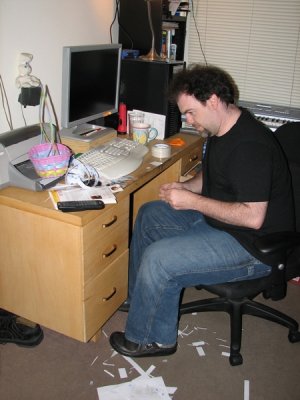
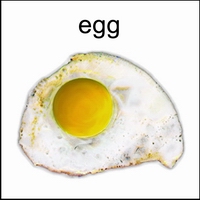
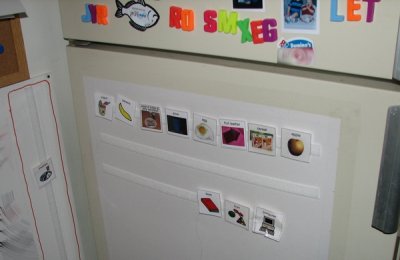 the visual schedule outlined in red to the left, the choice board on the front of the fridge in the middle/right side of photo. The choice board will have more lines on it as we get more cards and more velcro strips to put on the paper taped to the fridge. I also have a ’sentence strip’ that attaches to it, but it was on the top of the fridge when we made this. His therapist started working with that today. (He began “I want…” today at ST)
the visual schedule outlined in red to the left, the choice board on the front of the fridge in the middle/right side of photo. The choice board will have more lines on it as we get more cards and more velcro strips to put on the paper taped to the fridge. I also have a ’sentence strip’ that attaches to it, but it was on the top of the fridge when we made this. His therapist started working with that today. (He began “I want…” today at ST)
